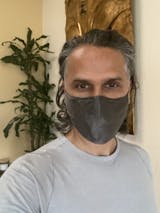Exfoliants are an important skincare addition to our skincare ritual. The use of exfoliants dates back to ancient civilizations such as American Indians using dried corn cobs, Native Comanche tribes using sand, Polynesians using crushed seashells, and Egyptians using a pumice stone.
Exfoliants smooth out and remove debris from the surface of the skin. The original formulations in modern times contain a cream or gel base with sugar, salt, sand, or crushed-up shell from a nut or seed. But you can now also find non-abrasive exfoliants that contain active ingredients that do the work for you.
Shed Like a Snake
A snake sheds her skin between four and 12 times a year. Although we are mammals, humans are not so different from these reptilian slugs. Every 2-4 weeks, humans will shed the entire outer layer of their skin!
Shedding is a protective mechanism that protects us from diseases. In addition, studies show that shedding also improves air quality around us. The oils and squalene found in our cells reduce the amount of ozone in the air. Ozone is a pollutant that can irritate our eyes, nose, and throat.
Because the skin sheds over 2-4 weeks, it does so in an uneven fashion. So our complexion and our overall skin can look dull and coarse in different areas. Makeup won’t go on as smoothly, and products won’t absorb.
The Benefits of Exfoliating
The human body is pretty darn amazing at keeping us healthy and alive. But it doesn’t hurt to help it along the way. Removing, or “sloughing off” — as the professionals call it — the dead skin cells through exfoliation accelerates the shedding process, which, in turn, helps:
- Unclog pores: although our skin sheds naturally, it can sometimes remain in small amounts that can seal or block our pores, causing things like blackheads and whiteheads;
- Prevent acne: not only does it unclog pores, but it aids in the management of acne and stops it from forming underneath the skin. Exfoliant removes bacteria that cause acne before it has a chance to infect the follicles;
- Allows for better penetration of skincare products: exfoliation unclogs pores and removes debris from the skin surface will, giving products a more straightforward path to infiltrate the epidermis without anything interfering with the process;
- Evens out skin tone: exfoliation smooths out any rough patches while helping with any pigmentation or dark spots as it sloughs off the dry, dead cells;
- Boosts circulation: exfoliation stimulates blood flow to the area it is working on. This helps with oxygenation of the skin and draws red blood cells - which create collagen - to the surface, which can also aid in skin repair;
- Stimulates cell renewal: exfoliation invigorates cells to encourage them to replenish; and,
- Collagen synthesis: exfoliation stimulates collagen production, minimizing fine lines and keeping the skin looking juicy.
The Types of Exfoliants
You’ll find an abundance of exfoliants available today, in various forms, for different uses and skin concerns. So how do you know which ones are best for your skin type and your needs?
There are two ways you can exfoliate:
- Physical exfoliation. This is the traditional style of exfoliation, where a product contains small particles, such as sugar or coffee grounds. This product requires manual application or rubbing of the skin, such as the Santal Dual-Action Enzyme Cleansing Powder by MS Skincare. Physical exfoliation also includes microdermabrasion, where tiny crystals are blown onto the skin through a handheld wand to resurface the skin’s outer layer.
- Chemical exfoliation. These are acids usually in liquid form that you apply to the skin, either as a mask in a treatment that you remove after a certain amount of time, such as MS Skincare’s Enlighten Retexturizing Glycolic Treatment; or as a step in your regime that stays on the skin. An example is the Hawaiian Beauty Water from Honua Skincare.
Physical Exfoliation Damage
Any good esthetician will tell you that you need to be very careful with exfoliation. In particular, when it comes to physical exfoliation, it’s so easy to damage the skin and not even realize it. The reason is that the particles in these kinds of exfoliants are not always ground up fine enough, and the particles are not perfectly round, meaning that they likely contain sharp edges.
Speaking of round particles, for anyone old enough to remember skincare 20+ years ago, almost every product on the shelf contained plastic microbeads instead of organic particles. Skincare companies claimed it was better and safer to use because the beads could help remove the product from the skin, and the microbeads were not as sharp or damaging to our skin.
Fast forward to the beginning 21st century, it became evident that we had a microplastics problem. Microplastics have become such a problem now that they’ve been found everywhere, from waterways to food.
Moving on.
When you manually exfoliate with these products, you control how hard you press into the skin and how much you scrub. So most of us will go to town on our face to dig into those areas bugging us.
Over-exfoliating and exfoliating with low-quality products will damage your skin’s microbiome. You’ve probably heard the word microbiome before to describe your gut or other parts of your body. A microbiome is just the name given to the ecosystem of bacteria - whether it be your skin or your gut, or some other area. The sound of having these tiny bugs crawling all over your skin might sound disgusting, but they are essential to the health of your skin.
Signs that you have damaged the skin’s microbiome will be evident on your skin fairly quickly. Your skin may look or feel:
- Irritated
- Red
- Inflamed
- Bumpy (with breakouts)
- Dry and flaky
- Patchy or blotchy
- Leathery
- Sensitive
- Premature signs of aging (fine lines)
Not only that, but there will be things going on with your skin that you won’t be able to see.
On a microscopic level, over-exfoliating with a manual exfoliant can cause micro-tears (cuts) in your epidermis. But why does that matter if they’re so small that you can’t even see them with your naked eye?
Well, those micro-tears leave skin vulnerable to bacteria and damage. It can also cause premature aging.
A great example of a well-known skincare product known to cause micro-tears in the skin is St Ives Apricot Scrub.
This product contains crushed-up corn kernels - yikes! Imagine how jagged those particles are. When you use it, your skin feels incredibly smooth - and it should, seeing as you buffed all of the debris, plus pieces of your epidermis away. But this is not how you safely and effectively treat your skin.
Chemical Exfoliation Damage
There are three kinds of chemical exfoliants:
- AHA’s (alpha-hydroxy acids) are water-soluble compounds, great for treating surface conditions such as fine lines, pigmentation, and skin texture; and,
- BHA’s (beta hydroxy acids) are oil-soluble compounds that work more effectively in the skin to unclog pores and treat acne; and,
- Fruit Enzymes come from fruit and work by breaking down or “eating” the dead skin cells.
Damage can also occur with chemical exfoliation. But as long as you follow the instructions for these products, including patch testing the product before using it, it is less likely that you will damage your skin.
Signs that you have over-exfoliated with a chemical exfoliant will be similar to physical exfoliation damage. The only thing that can’t occur is the micro-tears in the skin. But it is possible to get chemical burns from products if left on the skin too long or if you react to the chemicals.
Which Exfoliant Should I Use?
I always recommend exfoliation at least once a week for sensitive, normal, or dry skin and at least twice a week if you have oily or blemish-prone skin. This will facilitate your skin’s natural shedding and ensure your other products can effectively penetrate the skin.
If you have skin concerns like fine lines, sun damage, pigmentation, uneven skin texture, and large pores, you’ll want to get an AHA or Fruit Enzymes exfoliant. Our top picks are:
- MS Skincare’s Santal Dual-Action Enzyme Cleansing Powder - gentle enough to use daily, this incorporates physical and chemical exfoliation and removes a daily build-up of dead skin cells to maintain the integrity of your skin;
- Honua Skincare’s Hawaiian Beauty Water - apply up to 5 times a week; after cleansing, do not rinse off; continue with other products in your regime;
- MS Skincare’s Enlighten Retexturizing Glycolic Treatment - use once or twice a week, apply after cleansing, rinse off after 1-5 minutes, continue with other products in your regime;
- MS Skincare’s Jaipur Brightening Enzyme Mask - use 1-3 times a week, apply as a mask after cleansing, rinse off after 3-5 minutes, continue with other products in your regime.
BHA’s are great for acne, clogged pores, or oily skin concerns. You could try something like Paula’s Choice BHA Exfoliant. However, these days you can find products that contain combinations of AHA’s and BHA’s. So why not kill five birds with one stone?
I haven’t been able to find a BHA exfoliant in a 100% plastic-free container. The Ordinary comes in a glass dropper bottle with a plastic lid, and Paula’s Choice comes in plastic. Nevertheless, both products are very effective:
- The Ordinary’s AHA 30% + BHA 2% Peeling Solution - use twice a week, apply after cleansing, rinse off and continue with other products in your regime;
- Paula’s Choice 25% AHA + 2% BHA Exfoliant Peel - use once a week for 10 minutes after cleansing, rinse off and continue with other products in your regime.
As always, patch test any new skincare product before you use them. Chemical exfoliants contain very active ingredients and can cause uncomfortable and sometimes severe skin reactions. Use with caution.
Emma Jade has been a trained esthetician for over 15 years. She is a sustainable skincare writer, educating and building awareness around proper skin health that doesn’t cost the Earth.
Some of the products promoted in our blog are from our online store. Many others are brands we have researched and found to be great examples of sustainable, ethical, and innovative brands in their field, and we don’t profit from mentioning them in our blog. #CollaborationOverCompetition










